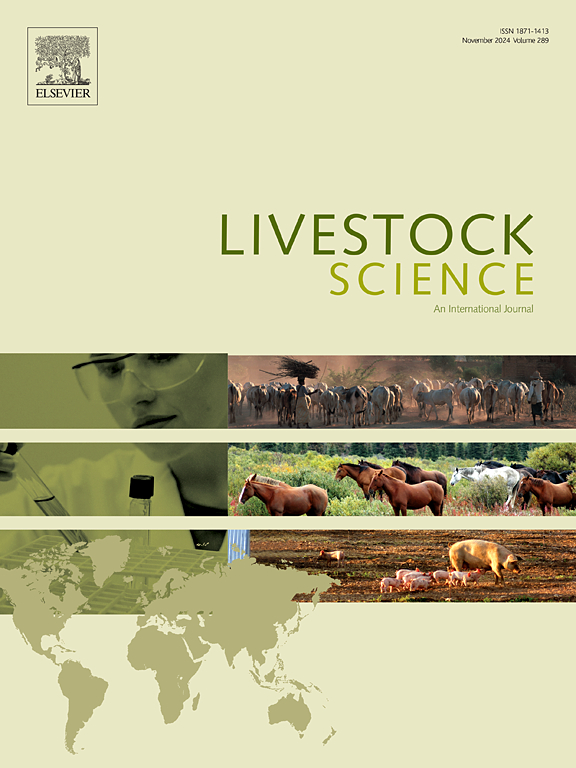Ingestive behaviour, performance, and methane emissions of pregnant alpacas grazing cultivated pastures in the high Peruvian Andes
IF 1.9
3区 农林科学
Q2 AGRICULTURE, DAIRY & ANIMAL SCIENCE
引用次数: 0
Abstract
This study compares grazing patterns, animal performance, and enteric methane emissions (CH4) of female alpacas (Huacaya and Suri) at two periods of their late pregnancy. Animals were rotationally grazed on a mixed sward at high Peruvian Andes conditions. This study involved two experimental periods (P1 and P2), each lasting 26 days. P1 took place in November 2021, corresponding to the end of dry season (‘Transition period’), whereas P2 was conducted in January 2022, with this coinciding with the beginning of rainy season (‘Wet period’). Forage selectivity was measured using hand plucking of forage harvested, whereas grazing behaviour was recorded by visual observation. Dry matter intake (DMI) was estimated from total faecal collection and in vitro forage digestibility. Fleece characteristics were measured following standard procedures adopted by the local industry. The sulphur hexafluoride (SF6) gas-tracer technique was used to estimate CH4 emissions. Data were analysed by a repeated measures model including both alpaca variety and period as fixed effects, whereas alpaca within variety was considered as random. No differences were detected among alpaca varieties either in terms of forage selectivity, grazing behaviour (except for biting rate) or feed intake. Regardless of period, grasses were the main dietary components (≥ 78 %). The proportion of leaves consumed lowered from 84 to 70% and presence of both legumes and herbs increased during P2. Increased nutritional requirements prior to parturition in conjunction with reduced forage quality and DMI (P = 0.004) during P2 led to negative energy and protein balances. This was aligned with increases in fibre growth and diameter, prior to parturition (P ≤ 0.035). Suri displayed faster fibre growth than Huacaya (P = 0.005). Although Huacaya females tended to emit more enteric CH4 per unit of metabolic live weight than Suri (P = 0.056), this was not reflected either on variety differences in emissions per unit of intake or fleece produced. On average, CH4 intensity decreased from 0.805 (P1) to 0.530 g/kg clean fleece at P2 (P = 0.032). Results are valuable towards fine-tuning the effect of pregnancy for sustainable alpaca farming.

在秘鲁安第斯山脉高海拔地区放牧的怀孕羊驼的摄食行为、表现和甲烷排放
本研究比较了华卡亚羊驼和苏里羊驼妊娠后期两个阶段的放牧模式、动物生产性能和肠道甲烷排放。在秘鲁安第斯山脉的高条件下,动物在混合草地上轮流放牧。本研究分为两个实验阶段(P1和P2),每个阶段持续26天。P1在2021年11月进行,对应于旱季的结束(“过渡期”),而P2在2022年1月进行,恰逢雨季的开始(“湿期”)。用手采摘收获的牧草来测量牧草选择性,而放牧行为通过目视观察来记录。干物质采食量(DMI)由粪便收集总量和体外饲料消化率估算。羊毛特性是按照当地工业采用的标准程序测量的。采用六氟化硫(SF6)气体示踪技术估算CH4排放量。数据分析采用重复测量模型,其中羊驼品种和周期作为固定效应,而品种内羊驼被认为是随机的。不同品种羊驼在饲料选择、放牧行为(咬伤率除外)和采食量方面均无差异。无论哪个时期,草料都是主要的饲粮成分(≥78%)。叶片消耗比例从84%下降到70%,豆科植物和草本植物的存在都增加了。分娩前营养需求增加,P2期饲料质量和DMI降低(P = 0.004),导致能量和蛋白质负平衡。这与分娩前纤维生长和直径的增加一致(P≤0.035)。苏丽的纤维生长速度快于华卡雅(P = 0.005)。虽然华卡雅母羊的单位代谢活重肠道CH4排放量高于苏瑞(P = 0.056),但这并没有反映在单位采食量和产绒量的品种差异上。CH4强度平均从P1的0.805 g/kg下降到P2的0.530 g/kg (P = 0.032)。结果对微调怀孕对可持续羊驼养殖的影响有价值。
本文章由计算机程序翻译,如有差异,请以英文原文为准。
求助全文
约1分钟内获得全文
求助全文
来源期刊

Livestock Science
农林科学-奶制品与动物科学
CiteScore
4.30
自引率
5.60%
发文量
237
审稿时长
3 months
期刊介绍:
Livestock Science promotes the sound development of the livestock sector by publishing original, peer-reviewed research and review articles covering all aspects of this broad field. The journal welcomes submissions on the avant-garde areas of animal genetics, breeding, growth, reproduction, nutrition, physiology, and behaviour in addition to genetic resources, welfare, ethics, health, management and production systems. The high-quality content of this journal reflects the truly international nature of this broad area of research.
 求助内容:
求助内容: 应助结果提醒方式:
应助结果提醒方式:


